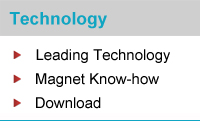 |
|
|
|
|
 |
| | | |||


|
| Your Location:
Technology - Magnet Know-how |
||
| |
|
Magnet Know-how [ 1 ] About Rare-earth Permanent Magnet [ 3 ] [ 4 ] [ 5 ] |
| |
|
|
About
Rare-earth Permanent Magnet A neodymium magnet (also known as NdFeB, NIB or Neo magnet), the most widely used type of rare-earth magnet, is a permanent magnet made from an alloy of neodymium, iron and boron to form the Nd2Fe14B tetragonal crystalline structure. Developed in 1982 by General Motors and Sumitomo Special Metals, neodymium magnets are the strongest type of permanent magnet commercially available. They have replaced other types of magnets in the many applications in modern products that require strong permanent magnets, such as motors in cordless tools,hard disk drives and magnetic fasteners. Production there are two principal neodymium magnet manufacturing methods:
Sintered Nd-magnets are prepared by the raw materials being melted in a furnace, cast into a mold and cooled to form ingots. The ingots are pulverized and milled; the powder is then sintered into dense blocks. The blocks are then heat-treated, cut to shape, surface treated and magnetized. In 2015, Nitto Denko Corporation of Japan announced their development of a new method of sintering neodymium magnet material. The method exploits an "organic/inorganic hybrid technology" to form a clay-like mixture that can be fashioned into various shapes for sintering. Most importantly, it is said to be possible to control a non-uniform orientation of the magnetic field in the sintered material to locally concentrate the field to, e.g., improve the performance of electric motors. Mass production is planned for 2017. As of 2012, 50,000 tons of neodymium magnets are produced officially each year in China, and 80,000 tons in a "company-by-company" build-up done in 2013. China produces more than 95% of rare earth elements, and produces about 76% of the world's total rare-earth magnets. Bonded Nd-magnets are prepared by melt spinning a thin ribbon of the NdFeB alloy. The ribbon contains randomly oriented Nd2Fe14B nano-scale grains. This ribbon is then pulverized into particles, mixed with a polymer, and either compression- or injection-molded into bonded magnets. Bonded magnets offer less flux intensity than sintered magnets, but can be net-shape formed into intricately shaped parts, as is typical with Halbach arrays or arcs, trapezoids and other shapes and assemblies (e.g. Pot Magnets, Separator Grids, etc.). There are approximately 5,500 tons of Neo bonded magnets produced each year. In addition, it is possible to hot-press the melt spun nanocrystalline particles into fully dense isotropic magnets, and then upset-forge or back-extrude these into high-energy anisotropic magnets. Magnetic Properties Some important properties used to compare permanent magnets are:
Neodymium magnets have higher remanence, much higher coercivity and energy product, but often lower Curie temperature than other types. Neodymium is alloyed with terbium and dysprosium in order to preserve its magnetic properties at high temperatures. The table below compares the magnetic performance of neodymium magnets with other types of permanent magnets. |
|||
